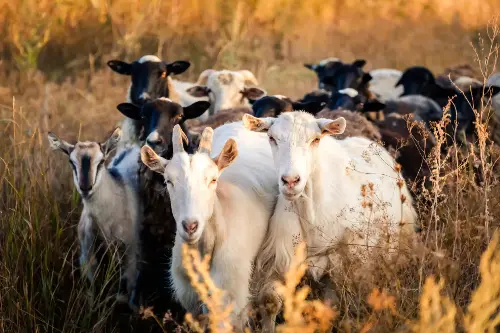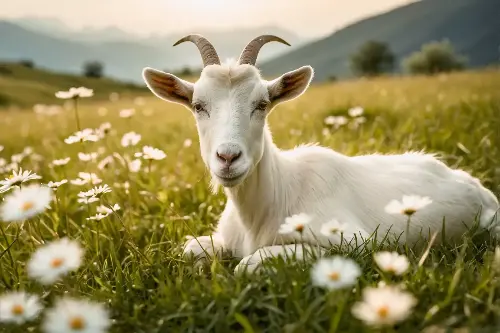The enigmatic goat, with its piercing eyes and nimble nature, has a story that spans thousands of years, intertwining with human civilisation in ways that have shaped both the creature and the cultures it has touched. From ancient domestication to their global impact and fearless spirit, goats have more to their narrative than meets the eye.

Ancient Beginnings
Trace the lineage of goats, and you'll find yourself journeying back to 10,000 BC, where their domestication story is believed to have begun in the Zagros Mountains, which span across the modern-day Iran-Iraq border. These early goats were tamed from the Bezoar ibex, a wild mountain goat recognised for its tenacity and ability to adapt to harsh environment. It's this resilient nature that made them prime candidates for the nomadic groups seeking a reliable food source.
As societies grew, so did the significance of goats, evolving from a mere commodity to a creature steeped in symbolism and necessity. Goats were associated with fertility and abundance in various ancient cultures, featuring prominently in mythologies and folklore worldwide.
Branching Across Continents
Goats are now a global phenomenon, but their journey from the cradle of civilisation to other parts of the world is a testament to their versatility and human enterprise. As explorers and traders set off across land and sea, goats became both cargo and companions, known for their hardiness and ability to thrive where other animals would falter. They were, and still are, a mobile food source, providing milk, meat, and hides for a variety of uses.
By introducing goats to new regions, ancient humans inadvertently reshaped ecosystems — an impact still felt today. On islands and in remote habitats, goats introduced by sailors as a food reserve have become wild and, in some cases, feral, often leading to significant environmental changes due to their grazing habits.
Fearless Spirit
One can scarcely discuss goats without noting their remarkable spirit. Goats are renowned for their agility and boldness, scaling steep cliffs and perching on precarious ledges with ease. This fearlessness isn't just a physical attribute but a metaphor for their ability to overcome challenges and adapt.
In studies of animal intelligence, goats have demonstrated impressive cognitive abilities, from complex problem-solving to long-term memory retention. Researchers have found that goats are capable of learning and remembering tasks for extended periods, indicating a level of intelligence that aligns with their survival skills.
Cultural Icons and Companions
Throughout history, goats have earned their place in the human story not only through agriculture and environment but also in our arts and cultural narratives. The Greek god Pan, with his goat-like features, embodies both the untamed wild and the allure of music and merriment. These creatures have also woven their way into children's tales, idioms, and even as signs of the zodiac.
In recent years, goats have gained popularity in urban and suburban settings as eco-friendly lawn mowers, their natural propensity to graze making them ideal for sustainable landscaping. Moreover, goat yoga has become a delightful trend, combining the therapeutic effects of animal-assisted therapy with the physical benefits of yoga, all while these lovable creatures frolic around participants.

The Green Impact of Goats
Beyond companionship and cultural significance, goats can play an essential role in land management and ecological balance. Their natural foraging behaviour makes them effective at controlling invasive plant species and reducing bushfire risk by clearing out potential fire fuel. As such, goats are increasingly considered valuable assets in managing land in both rural and semi-urban environments.
In agriculture, goats continue to be a source of sustainable production. Their milk yields cheeses like chèvre and feta, beloved in culinary circles. Goat meat, considered a healthier alternative to other red meats, is a staple in dishes across the globe.
Guardians of Tradition and Innovation
Despite their ancient roots, goats remain at the vanguard of agricultural innovation. As the world grapples with food security and sustainable practices, goats stand out for their low-impact on the environment compared to other livestock. Their ability to convert poor-quality forage into milk and meat, and their less demanding space and water requirements, position them as a key species in the future of farming.
Goats have also played a part in medical advancements. Their milk has unique properties that have been leveraged to create medications and treatments for human diseases. They have even been genetically modified to produce milk with therapeutic proteins for conditions such as cystic fibrosis.
In conclusion, goats are far more than just farm animals or quirky pets. They are companions of the past, architects of ecosystems, icons of culture, and potential keys to future sustainability. Their ancient domestication journey reveals a bond with humans that is both enduring and transformative, showcasing that the humble goat indeed harbours mysteries as deep as their ancient eyes suggest. As we continue to forge a path towards a balanced coexistence with nature, the goat stands as a beacon of adaptability, resourcefulness, and an emblem of humanity's rich and diverse history with the animal world.
